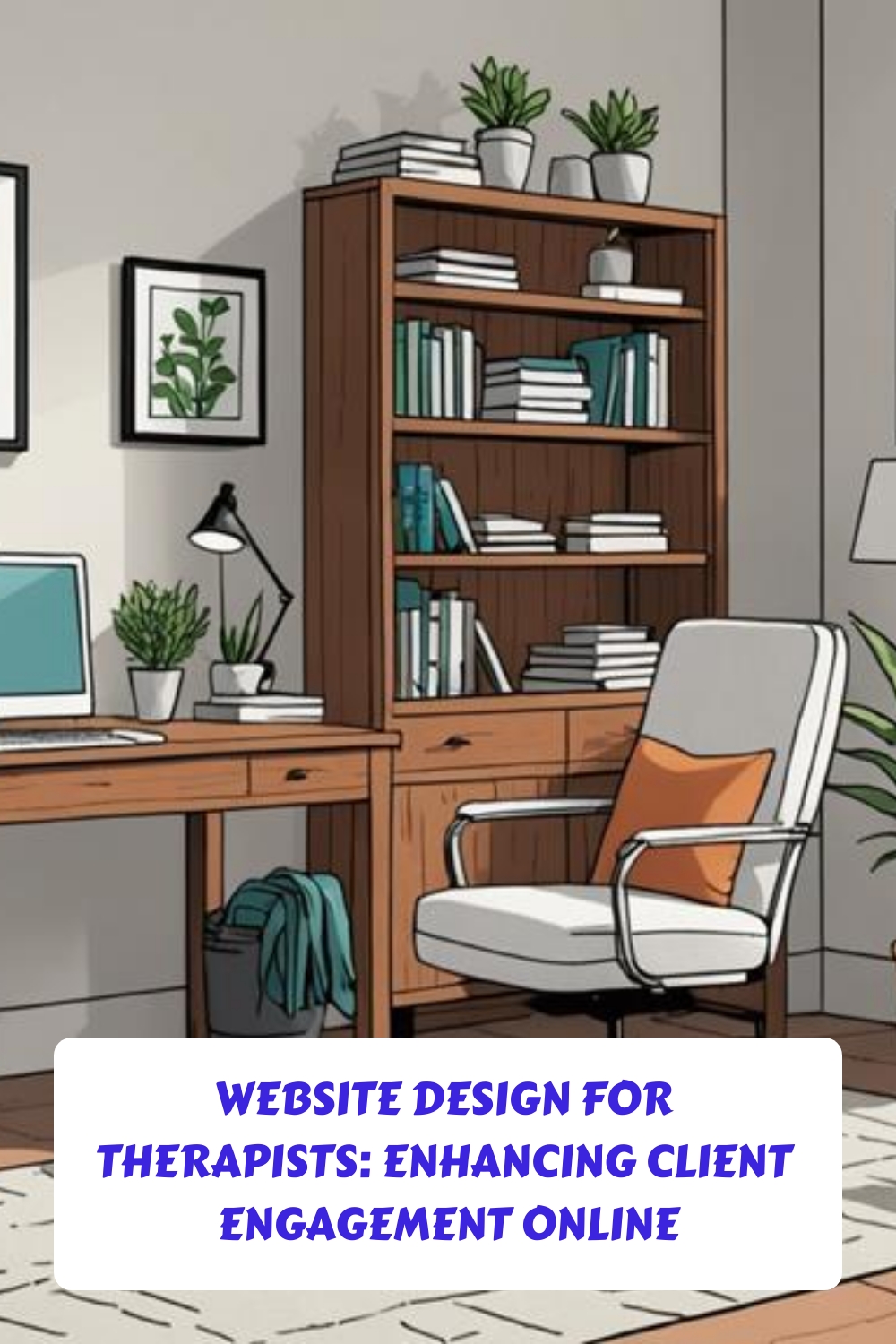
A well-designed website is key for therapists to connect with clients and enhance their online experience. You'll attract visitors with soothing colors and clear navigation, making it easy for them to find help. Understanding your audience's needs helps you create relatable content, like testimonials and articles, that builds trust. Mobile-friendly designs are essential since most users browse on their phones. Engaging features, like quizzes and informative videos, keep clients interested and encourage them to reach out. Investing time in these strategies will deepen client connections and improve engagement, ultimately leading to a positive impact on your practice. There's so much more to explore!
Key Takeaways
- A professional website design significantly increases client attraction, with strong first impressions boosting inquiry rates by up to 200%.
- Understanding your target audience's demographics and challenges is essential for creating tailored content that fosters engagement and connection.
- Mobile-friendly design is crucial, as over 50% of internet traffic comes from mobile devices, and responsive sites enhance engagement potential by 67%.
- Showcasing authentic client testimonials in various formats builds credibility and emotional connections, potentially increasing inquiries by up to 200%.
- Regular website updates and analytics monitoring are vital for optimizing user experience and ensuring the site remains relevant and effective.
Importance of Professional Design

A well-designed website can make all the difference in attracting clients to your therapy practice. An effective website isn't just about looks; it creates a strong first impression that can boost client inquiries and engagement. When potential clients visit a professional website, they feel a sense of warmth and understanding that's essential to the therapeutic process. In fact, research shows a strong design can improve inquiry rates by up to 200%! By incorporating custom brand building services, you can guarantee that your website resonates with your target audience and reflects your unique therapeutic approach.
Imagine your website featuring original visuals, soothing color schemes, and unique typography. These elements transform a simple informational site into a enchanting experience that resonates with visitors. Engaging design techniques, like parallax scrolling or whimsical illustrations, can create a humanized, approachable brand image that fosters trust and connection.
When clients feel welcomed and understood through your website, they're more likely to reach out for help. On the flip side, a poorly designed website can lead to frustration and lost opportunities. So, investing time and effort into a professional design isn't just smart; it's essential for enhancing client engagement. With the right design, you're not just presenting information; you're inviting clients into a space where they feel safe and valued.
Understanding Your Target Audience
To truly connect with your clients, you need to understand who they are. Think about their age, interests, and the challenges they face; this helps you create a website that speaks directly to their needs. By showing cultural sensitivity and fostering emotional connections, you can make your site a welcoming place for everyone who visits.
Demographic Insights
Understanding your target audience's demographics is essential for effective website design, as it directly influences how potential clients perceive and engage with your services. By focusing on demographic factors like age, gender, and location, you can create content that resonates more with your target audience. For instance, millennials and Gen Z often seek therapy online, so having a mobile-friendly design is key to reaching them.
Cultural sensitivity plays a critical role in your website. Clients from diverse backgrounds have different experiences and expectations regarding mental health services. By being aware of these differences, you can design a website that feels welcoming to everyone.
Additionally, understanding how your target audience prefers to communicate is crucial. Younger clients might lean towards social media for interaction, while others may still favor traditional emails. Tailoring your communication channels based on demographic insights helps you engage clients more effectively.
Emotional Connection
Creating an emotional connection with your audience is crucial for the success of your therapy practice's website. When you understand who your clients are, you can create engaging content that speaks directly to their needs and values. Think about their challenges and pain points. By addressing these directly, you show that you truly understand their struggles, fostering that important emotional connection.
It's also essential to use language and imagery that makes everyone feel included and welcomed. This promotes trust and credibility, making potential clients more likely to reach out. When you share relatable stories or personal insights, it helps your audience see themselves in your practice, increasing their emotional investment.
Consider where your target audience spends their time online. Knowing their preferred communication channels allows you to place your content strategically, providing support and connection. The more they feel understood, the more they'll engage with your site. So, take the time to learn about your audience; it's the key to building lasting relationships. With the right approach, you can create a website that not only attracts clients but also helps them feel at home.
Cultural Sensitivity
Recognizing and respecting the diverse backgrounds and beliefs of your clients is crucial for building an inclusive therapy practice. Cultural sensitivity isn't just a buzzword; it's an important part of connecting with clients. When you tailor your website design and content to reflect the cultural demographics of your audience, you create valuable content that speaks directly to them. This shows potential clients that you understand their unique experiences, helping to build trust and connection.
Using culturally appropriate imagery and language can make a big difference too. For instance, if you serve a community with specific cultural traditions, showcase those in your marketing materials. This representation helps clients feel understood and valued. By incorporating resources that address the specific needs of different cultural groups, you demonstrate awareness of their challenges, which can enhance the therapeutic relationship.
Additionally, investing in training for cultural competence guarantees you're equipped to meet the needs of diverse clients. This isn't just about inclusivity; it's about creating an effective therapeutic environment where everyone feels welcomed. By embracing cultural sensitivity, you lay the groundwork for deeper connections and more successful therapy outcomes.
Core Strategies for Effective Websites

When you're designing your website as a therapist, think about how to make it easy for visitors to find what they need. Using simplified navigation and sharing your core values can really help connect with potential clients. Plus, making sure your site looks good on mobile devices is super important since many people browse on their phones these days!
Simplified Navigation Techniques
To guarantee your website resonates with visitors, simplified navigation is essential for enhancing user experience. When you make it easy for users to find what they need, studies show that engagement can increase by up to 50%. Start with a clear menu structure and consistent labeling. This helps users locate important information quickly, making their experience more enjoyable.
Organizing your content hierarchically allows visitors to access related information easily. Implementing breadcrumb navigation can guide them through your site, so they always know where they are. Don't forget about mobile-friendly design! Mobile users prefer thumb-friendly buttons and touch targets, which makes their navigation seamless and frustration-free.
A good rule of thumb is to confirm all navigation options are accessible within three clicks of the homepage. This best practice can greatly decrease visitor frustration and minimize bounce rates. By focusing on simplified navigation, you create a welcoming digital environment that encourages clients to explore your services. Remember, when clients can easily navigate your website, they're more likely to engage with you. So, take the time to enhance that experience; it's a small effort that can lead to big rewards!
Clear Core Values
A well-designed website not only simplifies navigation but also clearly communicates your core values, which are essential for building trust with potential clients. When visitors see your values displayed prominently, it shows that you're serious about helping them. Engaging content plays a key role here; it should reflect your core values and resonate with your audience.
Including a well-defined mission statement on your homepage can reinforce your commitment to client outcomes, giving visitors a clear understanding of what to expect from your services. This builds credibility and helps potential clients feel more comfortable reaching out.
Don't forget the power of client testimonials! These stories can humanize your practice and create emotional connections. When potential clients read about others' positive experiences, they're more likely to trust you with their own challenges.
Make sure your website's content aligns consistently with your core values across all pages. This unity creates a cohesive message, fostering a deeper understanding of your practice. By clearly communicating your core values, you set the stage for meaningful connections with clients who need your support.
Mobile-Friendly Design Importance
Mobile-friendly design is essential for therapists, as over half of internet traffic now comes from mobile devices. When potential clients search for mental health services, they want quick and easy access on their phones. If your website isn't mobile-friendly, you risk losing 62% of users who might not come back. Imagine missing out on local clients who need your help!
A responsive design improves user experience, leading to a 67% higher chance of engagement. This means more visitors will explore your site and reach out to you. Plus, Google loves mobile-friendly sites and ranks them higher in search results, making it easier for clients to find you.
Speed matters too! Studies show that 32% of visitors will leave a site if it takes too long to load. So, ensuring your site navigates smoothly on mobile devices can keep users interested and lower bounce rates.
In this digital age, making your website mobile-friendly isn't just a nice feature—it's a necessity. It helps you connect with clients when they need you most, enhancing their experience and increasing your chances of building a lasting relationship.
SEO Best Practices
SEO best practices are vital for therapists looking to attract more clients and enhance their online presence. By focusing on keyword optimization, especially long-tail keywords related to your therapy services, you can greatly boost your website's visibility. This means when someone searches for therapy in your area, your site stands a better chance of showing up.
Local SEO strategies are important too. Make sure to create and optimize your Google My Business listing. This helps you connect with potential clients nearby, driving more foot traffic to your practice. Regularly conducting SEO audits is another smart move. They'll help you identify any issues on your site, ensuring it runs smoothly and ranks well.
When crafting website content, focus on creating engaging, high-quality articles that address common client concerns. This not only improves your SEO but also positions you as an authority in your field. Additionally, earning backlinks from reputable mental health organizations or local directories can enhance your site's credibility. These strategies improve your SEO ranking and build trust with potential clients, paving the way for a thriving practice. Embrace these best practices, and watch your online presence grow!
Utilizing Testimonials

Testimonials serve as powerful endorsements for your therapy practice, greatly enhancing your credibility and trustworthiness. When potential clients read positive feedback, they feel more confident in choosing your mental health services. Here's how you can effectively utilize testimonials:
- Showcase Authentic Stories: Share real experiences from clients. Their journeys can inspire others facing similar challenges.
- Highlight Specific Outcomes: Focus on transformations, like improved mental well-being or better relationships. These details resonate emotionally with prospective clients.
- Use Varied Formats: Mix text, video, and audio testimonials. This variety makes it easier for visitors to connect with the stories in a way that suits them.
- Create a Dedicated Section: Make sure your testimonials are easy to find. A well-organized section on your homepage or services page can remarkably increase client inquiries, sometimes by up to 200%.
Social Media Integration
Social media integration can be a game-changer for your therapy practice, expanding your reach and connecting you with potential clients where they already spend their time. With around 70% of adults engaging on social media regularly, it's a prime opportunity to enhance your online presence. By sharing valuable mental health content, you can build trust and credibility. In fact, 82% of consumers feel more positive about brands that create custom content.
Engaging with clients on social media helps foster a sense of community and support. Did you know that 54% of social media users prefer interacting with brands through these platforms? This means that when you respond to comments or share uplifting posts, you're making a real connection. Plus, using social media for mental health advocacy can raise awareness, and in 2021, 56% of users reported more discussions about mental health on these platforms.
Collaborating with influencers in the mental health field can amplify your reach even further. This could lead to a 4x higher engagement rate compared to non-collaborated content. Embracing social media integration not only boosts client engagement but also shows you're a part of the conversation that matters.
Content Strategies for Engagement

Engaging content is essential for capturing the interest of potential clients and fostering a meaningful connection. By using effective content strategies for engagement, you can provide valuable information that truly resonates. Here are some strategies to take into account:
- Diverse Content: Use articles, infographics, and videos to reach different learning styles. These formats can simplify complex therapy concepts.
- Personal Stories: Share anonymized case studies that show real experiences. This builds relatability and helps ease potential clients' concerns about their own journeys.
- Expert Insights: Offer useful self-care tips and answer common questions. This positions you as a knowledgeable authority in mental health, fostering trust.
- Interactive Materials: Encourage engagement through quizzes or downloadable resources. These tools not only inform but also create a deeper connection with your audience.
Legal and Ethical Considerations
Maneuvering the legal and ethical landscape of website design is important for therapists. You must prioritize client confidentiality, ensuring that you never disclose identifiable information without explicit consent. This protects your clients and fosters trust, which is significant for any therapeutic relationship.
Informed consent is another key aspect. Before sharing testimonials or success stories, make sure clients understand how their information will be used. This clarity is crucial for ethical marketing practices. Remember, maintaining ethical boundaries is important too. Avoid conducting therapy sessions or giving diagnoses through social media; it's important to uphold your professional integrity.
You should also include clear disclaimers on your website. These disclaimers should explain the purpose of the information shared. This not only keeps you transparent but also protects both you and your clients. Additionally, having a proactive crisis management plan can help you address negative feedback or online interactions effectively. Stay informed about the legal regulations that impact your advertising and communication practices. By being mindful of these considerations, you can create a welcoming and safe online space for your clients, enhancing their engagement while respecting their rights and dignity.
Continuous Improvement and Monitoring

Continuous improvement is essential for maintaining an effective website that meets the needs of your clients. By regularly monitoring performance, you can discover what works and what doesn't. Here are four key strategies to help you along the way:
- Use Analytics Tools: Regular performance monitoring with tools like Google Analytics can track important metrics such as website traffic and conversion rates.
- Gather User Feedback: Collecting continuous feedback through surveys or direct inquiries gives you insights into your clients' needs and preferences, allowing for meaningful adjustments.
- Conduct SEO Audits: Implementing regular SEO audits helps you identify and fix issues that may hurt your website's visibility, ensuring you stay relevant in search results.
- Update Content Consistently: Adding new blog posts or resources not only enhances SEO but also keeps your website fresh and engaging for potential clients.
Frequently Asked Questions
How Can I Make My Website Mobile-Friendly for Clients?
To make your website mobile-friendly, you should implement mobile optimization techniques, embrace responsive design principles, and incorporate client interaction features. This way, your clients will enjoy a seamless experience on any device they use.
What Colors Are Best for a Therapist's Website?
Imagine a serene sunset; that's the vibe you want. Soothing palettes like soft blues and greens evoke calmness, aligning with color psychology. Choose colors that reflect your brand identity, creating a welcoming online space for clients.
How Often Should I Update My Website Content?
You should update your website content regularly, ideally every few months. Incorporate seasonal updates and fresh client testimonials into your content strategy to keep it engaging and relevant, ensuring clients always find valuable information.
Are There Specific Fonts That Are More Inviting for Therapy Websites?
Imagine a warm hug; that's how your font should feel. Pair inviting serif fonts with friendly sans serif ones. The right font pairings create emotional impact, making visitors feel welcomed and understood in your space.
How Do I Ensure My Website Is Accessible for All Clients?
To guarantee your website's accessible for all clients, use web accessibility tools, apply universal design principles, and integrate assistive technology. These steps create an inclusive experience, making it easier for everyone to engage with your content.
Final Thoughts
In the world of therapy, a well-designed website is like a warm, welcoming office—inviting and professional. By understanding your audience, using testimonials, and applying good SEO, you'll create a space that encourages connection. Think of your website as a bridge, linking you to clients who need your help. While challenges may arise, remember that continuous improvement can lead to greater engagement and success. With the right tools, you can make a positive impact online.
- How to Plan a Content Calendar That Works - 29/10/2025
- SEO Content vs. Social Media Content: What’s the Difference? - 23/10/2025
- The Best Types of Content for Service Businesses - 16/10/2025




